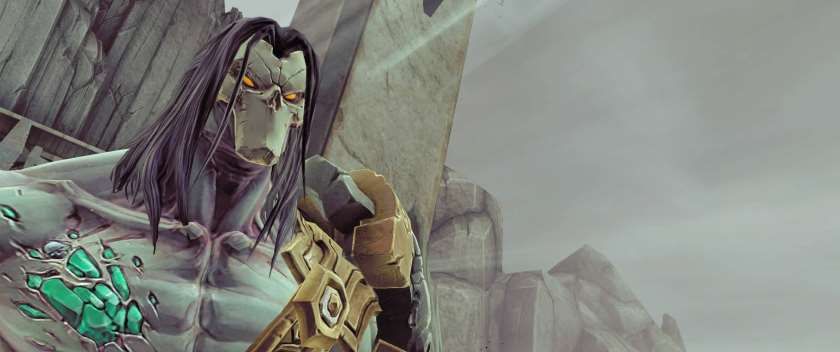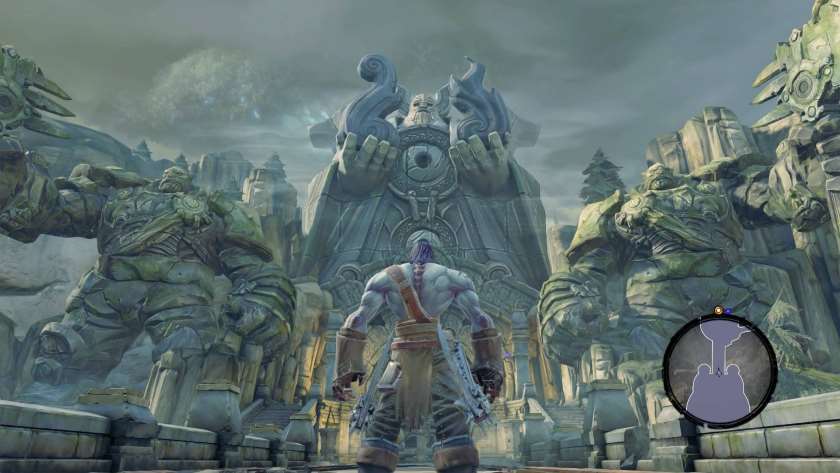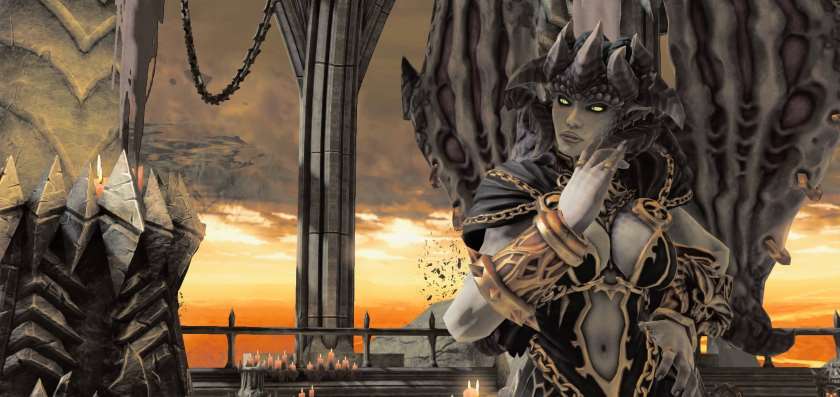The Death of Darksiders II

Snow soars past the panning camera towards frost-tipped mountains. Galloping through the ravines and climbing the pathways, the pale rider storms forth. Known to some as the Reaper, to others as Death, it is the name of Kinslayer that haunts him most. Death rides to not only save his horseman brother, but to perhaps assuage his soul. Maybe War’s salvation can make up for the murderous atrocity he had once committed against his nephilim brethren.
If you want to understand the basics of what makes a good character, look no further than the conflict Death must face versus that of War in Darksiders. That hulking, overly armored bladewielder battles enemies from without, but tussles none with demons within. Framed and betrayed, War’s entire journey is simply in learning who to aim his vengeance towards. Thoroughly epic and filled with the bloodlust that can only be quenched by tossing dice or mashing buttons on a controller, but hardly a resonant story.
Death rides in the guise of altruism, but it is the ghosts of his brothers long vanquished that haunt his soul. His journey is not to free his brother, but to instead free himself.
Unfortunately, the game has some trouble getting these ideas across.
I don’t mean that Vigil failed to effectively convey these concepts. They’re quite blatantly stated, and Death’s seeming obliviousness at times paints him a fool. It’s more that the game is filled with characters harshly asking if Death is truly prepared to face his destination. Be it the Tree of Life or Well of Souls, everyone else seems to know that “truth” exists at its root.
These sentiments are the only words given regarding the conflict, and they come only after Death has been nagged once again to perform some hardly related errand for whatever local authority resides.
Vigil Studios understood well enough that a character should be suffering some internal conflict which they need to progress through, but they seemed incapable of writing a story around anything but objective markers. None of the characters seem to really challenge Death or even the juxtaposition of his identity or mission. He yearns to restore humanity to life despite being the icon of finality. The first realm he visits is filled with beauty and the remnants of life while the second is a desolate wasteland of lost souls. These are realms that could have reflected on the nature of mortality, save that they were purely treated as locations to contain quests. That the player will also see three more additional realms lends the game to feeling confused.

We could argue that each realm certainly serves interpretations of life, death, and the hereafter, but not with any consistency or clarity of meaning in relation to Death’s journey. The realm of man and the realm of the Makers are both once vibrant worlds fallen to a hostile force: the former to the hordes of Hell and the latter to Corruption. The land of the dead, the realm of Hell, and the Heavenly outpost of Lostlight each reflect aspects of the afterlife, but only the land of the dead seems to act as juxtaposition to the notion of life and living as a concept.
If the writers ever intended these realms to mean anything, they never had enough development time to bring it all together in a decipherable fashion. They simply feel like playgrounds intended to give the player more territory to explore, climb, clamber, and slaughter.
Death’s adventure thus brooks no hard questions. Go here, slay this thing, bring me a trinket, and beware your final destination! Say it with a cackle or a foreboding tone and you’ve got every character Death encounters in his adventure.
If the reaping horseman is to be conflicted, then the story needs to be willing to ask him meaningful questions. In order to ask him meaningful questions there need to be meaningful characters. Darksiders II adds plenty of interesting and colorful characters to further build its universe, such as Ostegoth the merchant, but any character that could sustain a personal, tumultuous relationship with Death are cast aside or swept under the rug.
Take, for example, Lilith, the mother to all Nephilim. Introduced far too late into the game, she is the first character to really beg Death to revive his slain brethren at the Well of Souls rather than humanity. Sure, the Crowfather warns him that he must choose between the Nephilim and Humanity, but it is not enough to present a choice. Given Death’s irritable nature and distrust of his “mother”, we can already see plenty of his reasons for wanting to revive Humanity instead. Lilith does nothing to reveal Death’s reluctance to permanently extinguish the souls of his fallen brethren. We merely witness Death’s lack of trust in his “mother”.

Regardless of anyone’s personal feelings regarding sexuality in character designs, I think Lilith’s fails purely because she blends into the background. She lacks any features or qualities that help her stand out from the environment, save for her bosom.
Keep in mind we never actually witness Death’s remorse for his fratricide. All we know is that he asked the Crowfather to bear the crystalized souls of the slaughtered Nephilim. True, the other three horsemen agreed that their siblings could not be allowed to live if there were to be a Balance between realms. It was – or is implied to have been – Death’s decision alone to contain their souls in a crystal rather than let them vanish into nothingness.
Never does Death seem truly troubled by this decision until the very end – a moment that would have felt more appropriate had he been visibly tortured from start to finish. Keep in mind that I do not wish for all storytelling to be completely blunt, or for Death to stand from the tops of mountains and scream “I am conflicted!” The internal strife should be apparent in his arguments, where he seems non-committal to the very end.
I can only believe this failure to write a compelling narrative was the result of the game clearly being built to have “things to do”. More dungeons! More realms! More game! More, more, more! Yet “more” ultimately became less, and so Death, a far more interesting character than War, was given conflict without a proper arc.
There’s much to be enjoyed in his sarcasm and short temper. The voice actor does a phenomenal job and the dialogue sounds like every adolescent boy’s Dungeons and Dragons fantasies. If you continue to listen to heavy metal about dragon-slaying as I do, then you’ll find yourself loving the character regardless.
It’s just a shame that more could not be done with Death, as I have the feeling we won’t have another chance to properly delve into his character in the near future.


